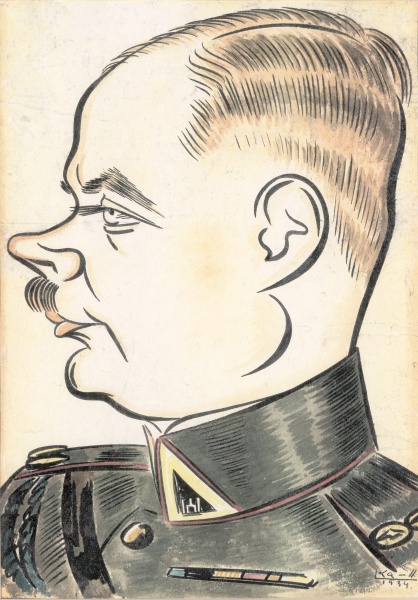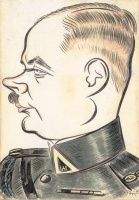
A Caricature of General Jonas Černius
| Author: | Lazaris Kaganas (1910–1941?) |
Lasar Kagan (b. 1910 Seda – d. ca 1941, Lithuania (?)). The Kagan family moved from Seda to Kaunas after the First World War. The father worked as a pharmacist, and the two sons, growing up in a wealthy family, were free to choose their professions. The older son Ovsey became a pianist, and Lazar became an artist. In 1928 and 1929, he studied at the Kaunas Art School. Kagan was an excellent draughtsman, and had no shortage of commissions: his caricatures and cartoons were published by leading interwar Lithuanian newspapers in Lithuanian, Russian and Yiddish. In 1932 and 1933 he organised a touring exhibition in Lithuanian cities, and became one of the country’s most famous cartoonists. From 1938 he lived in Stockholm, and in 1939 he lived in Copenhagen, where he published the cartoon book 100 Skandinaver: tegnet af L. Kaganas (100 Scandinavians: Images by L. Kagan). The book was so popular that it was reprinted in Copenhagen the same year, as well as in Oslo and Stockholm.
Source: Ellex Valiunas (LAWIN until 2015) art album: STORIES OF LITVAK ART (2023). Compiler and author Vilma Gradinskaitė.

Lasar Kagan (b. 1910 Seda – d. ca 1941, Lithuania (?)). The Kagan family moved from Seda to Kaunas after the First World War. The father worked as a pharmacist, and the two sons, growing up in a wealthy family, were free to choose their professions. The older son Ovsey became a pianist, and Lazar became an artist. In 1928 and 1929, he studied at the Kaunas Art School. Kagan was an excellent draughtsman, and had no shortage of commissions: his caricatures and cartoons were published by leading interwar Lithuanian newspapers in Lithuanian, Russian and Yiddish. In 1932 and 1933 he organised a touring exhibition in Lithuanian cities, and became one of the country’s most famous cartoonists. From 1938 he lived in Stockholm, and in 1939 he lived in Copenhagen, where he published the cartoon book 100 Skandinaver: tegnet af L. Kaganas (100 Scandinavians: Images by L. Kagan). The book was so popular that it was reprinted in Copenhagen the same year, as well as in Oslo and Stockholm.
Source: Ellex Valiunas (LAWIN until 2015) art album: STORIES OF LITVAK ART (2023). Compiler and author Vilma Gradinskaitė.






